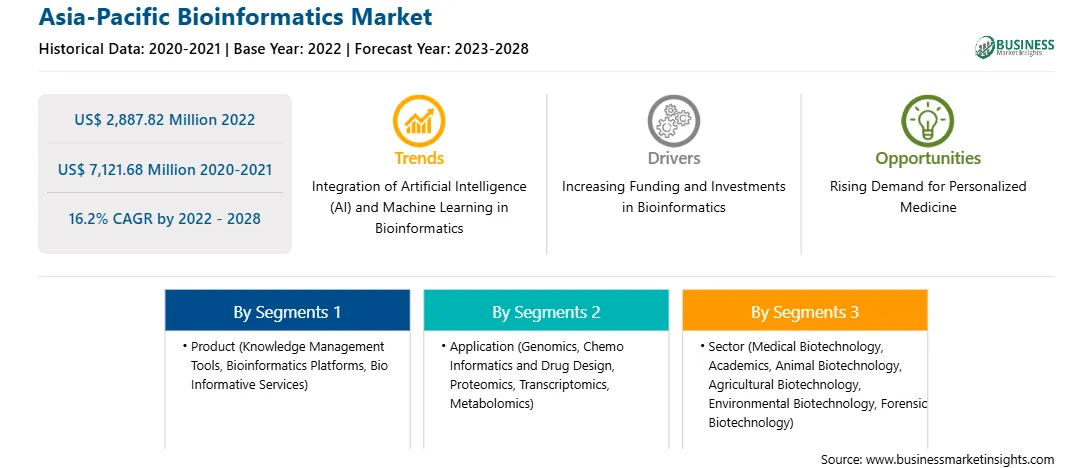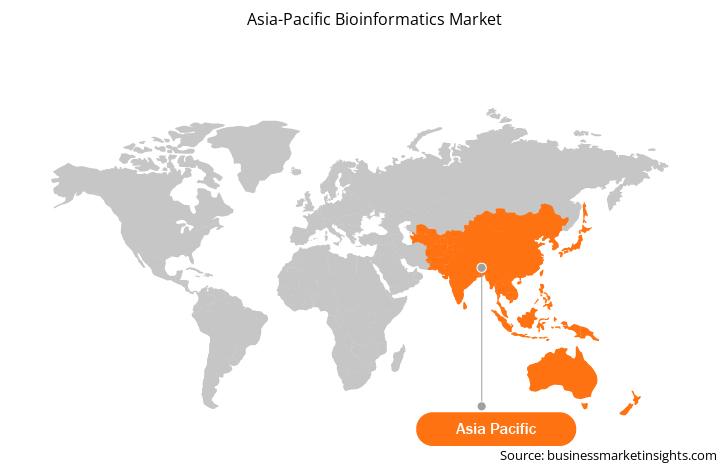Integration of Artificial Intelligence (AI) and Machine Learning in Bioinformatics To Drive Market Growth
Bioinformatics and AI play critical roles in changing and advancing the healthcare industry. In the context of bioinformatics, AI can be used to promote clinical research and analysis that can result in the design of new drugs and vaccines, the diagnosis of diseases, and even the prediction of pandemics. For example, AI can be used in conjunction with bioinformatics in wearable tech. Consumers are already familiar with many types of wearable techs, such as fitness trackers and watches, and make personal use of the data they collect. The wearable tech provides real-time data over a period and can help track trends and identify signs of potentially fatal health issues, such as heart disease, much quicker and more accurately than spot tests conducted in laboratories. Also, genome sequencing plays a pivotal role in medical diagnostics. Machine learning-empowered DNA sequencing techniques such as next-generation sequencing have made it possible for researchers to sequence human genomes within a day compared to the traditional sanger sequencing technology, which took over a decade to sequence a human genome. Thus, the integration of AI and machine learning in bioinformatics is expected to fuel the bioinformatics market over the forecast period.
Market Overview
The APAC bioinformatics market is segmented into China, India, Japan, South Korea, Australia, and Rest of APAC. China dominated the market in 2022. In China, the demand for genetic sequencing is fueled by the country’s growing middle class, aging population, and expanding healthcare system. Many companies are investing significant amounts into genetics research in the country. For instance, in January 2021, Illumina partnered with Sequoia Capital’s China-based subsidiary to launch a new incubator for genomics start-ups. Illumina will provide sequencing systems, reagents, and genomics expertise and will help outfit laboratory space, while the investment firm will help connect new companies and founders with entrepreneurs and financial advice, as well as provide approximately US$ 500,000 in upfront funding. Also, biotechnology is set to become a key driver of economic and social development in China, increasing the adoption of genomics. The local giant BGI Group is expanding its foothold in the gene-sequencing industry. The company has sold 35 million rapid COVID-19 testing kits to 180 countries and built 58 labs in 18 countries. The Chinese genomics industry is acquiring technologies crucial to advancement in the field to develop the infrastructure for genomics. For instance, in June 2020, Personalis, Inc., a leader in advanced genomics for cancer, partnered with Berry Genomics (China). Personalis is expanding its business operations in China with plans to form a fully-owned subsidiary in Shanghai. The expansion will include building a laboratory operation for local customers to use its ImmunoID NeXT PlatformTM, a commercial team to support local customers, and general and administrative functions. Also, owing to the growing advancements aided by government support, precision medicine research is proliferating in the region. For instance, in July 2018, GE Healthcare opened the GE Cell and Gene Therapy Asia Technology Center to train thousands of scientists in precision medicine-driven biopharma techniques. Further, 11 Chinese companies are using its biopharma production process, FlexFactory. Various strategic initiatives such as acquisitions, partnerships, and collaborations bolstered the growth of the country's market. For instance, in November 2020, Congenica, one of the UK's fastest-growing genomics companies, sold its stake to Tencent, a Chinese company, as part of the funding. Thus, owing to these advancements, the bioinformatics market is expected to grow at a rapid pace over the forecast period.
Strategic insights for the Asia-Pacific Bioinformatics provides data-driven analysis of the industry landscape, including current trends, key players, and regional nuances. These insights offer actionable recommendations, enabling readers to differentiate themselves from competitors by identifying untapped segments or developing unique value propositions. Leveraging data analytics, these insights help industry players anticipate the market shifts, whether investors, manufacturers, or other stakeholders. A future-oriented perspective is essential, helping stakeholders anticipate market shifts and position themselves for long-term success in this dynamic region. Ultimately, effective strategic insights empower readers to make informed decisions that drive profitability and achieve their business objectives within the market. The geographic scope of the Asia-Pacific Bioinformatics refers to the specific areas in which a business operates and competes. Understanding local distinctions, such as diverse consumer preferences (e.g., demand for specific plug types or battery backup durations), varying economic conditions, and regulatory environments, is crucial for tailoring strategies to specific markets. Businesses can expand their reach by identifying underserved areas or adapting their offerings to meet local demands. A clear market focus allows for more effective resource allocation, targeted marketing campaigns, and better positioning against local competitors, ultimately driving growth in those targeted areas.Asia-Pacific Bioinformatics Strategic Insights

Asia-Pacific Bioinformatics Report Scope
Report Attribute
Details
Market size in 2022
US$ 2,887.82 Million
Market Size by 2028
US$ 7,121.68 Million
Global CAGR (2022 - 2028)
16.2%
Historical Data
2020-2021
Forecast period
2023-2028
Segments Covered
By Product
By Application
By Sector
Regions and Countries Covered
Asia-Pacific
Market leaders and key company profiles
Asia-Pacific Bioinformatics Regional Insights

The APAC bioinformatics market is segmented based on product, application, sector, and country.
Based on product, the APAC bioinformatics market is segmented into knowledge management tools, bioinformatics platforms, and bio informative services. The bioinformatics platforms segment held the largest market share in 2022. Based on application, the APAC bioinformatics market is segmented into genomics, chemo informatics and drug design, proteomics, transcriptomics, metabolomics, and others. The genomics segment held the largest market share in 2022. Based on sector, the APAC bioinformatics market is segmented into medical biotechnology, academics, animal biotechnology, agricultural biotechnology, environmental biotechnology, forensic biotechnology, and others. The medical biotechnology segment held the largest market share in 2022. Based on country, the APAC bioinformatics market has been categorized into China, India, Japan, South Korea, Australia, and Rest of APAC. Further, China dominated the market in 2022. Agilent Technologies, Inc.; Bruker Corporation; Dassault Systèmes; Eurofins Scientific; Illumina, Inc.; PerkinElmer Inc.; QIAGEN; and Thermo Fisher Scientific Inc. are the leading companies operating in the APAC bioinformatics market
The Asia-Pacific Bioinformatics Market is valued at US$ 2,887.82 Million in 2022, it is projected to reach US$ 7,121.68 Million by 2028.
As per our report Asia-Pacific Bioinformatics Market, the market size is valued at US$ 2,887.82 Million in 2022, projecting it to reach US$ 7,121.68 Million by 2028. This translates to a CAGR of approximately 16.2% during the forecast period.
The Asia-Pacific Bioinformatics Market report typically cover these key segments-
The historic period, base year, and forecast period can vary slightly depending on the specific market research report. However, for the Asia-Pacific Bioinformatics Market report:
The Asia-Pacific Bioinformatics Market is populated by several key players, each contributing to its growth and innovation. Some of the major players include:
The Asia-Pacific Bioinformatics Market report is valuable for diverse stakeholders, including:
Essentially, anyone involved in or considering involvement in the Asia-Pacific Bioinformatics Market value chain can benefit from the information contained in a comprehensive market report.